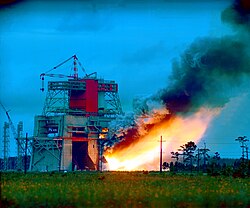Stennis Space Center
 |
|
 The B-1/B-2 Test Stand holding space shuttle components (1987) |
|
| Agency overview | |
|---|---|
| Formed | 1961 |
| Preceding agencies |
|
| Jurisdiction | U.S. federal government |
| Headquarters | Hancock County, Mississippi |
| Agency executive |
|
| Parent agency | NASA |
| Website | Stennis Space Center home page |
|
Rocket Propulsion Test Complex
|
|

Static Test Firing S-1C Saturn V Mississippi Test Facility MTF
|
|
| Location | Bay St. Louis, Mississippi |
|---|---|
| Built | 1965 |
| Architect | NASA |
| NRHP Reference # | 85002805 |
| Significant dates | |
| Added to NRHP | October 3, 1985 |
| Designated NHL | October 3, 1985 |
The John C. Stennis Space Center (SSC) is a NASA rocket testing facility. It is located in Hancock County, Mississippi, on the banks of the Pearl River at the Mississippi–Louisiana border. As of 2012[update], it is NASA's largest rocket engine test facility. There are over 30 local, state, national, international, private, and public companies and agencies using SSC for their rocket testing facilities.
The initial requirements for NASA's proposed rocket testing facility required the site to be located between the rockets' manufacturing facility at Michoud Assembly Facility in eastern New Orleans, Louisiana and the launch facility at the Kennedy Space Center in Florida. Also, the site required barge access as the rocket motors to be tested for Apollo were too large for overland transport.
NASA announced formation of the Mississippi Test Facility (now known as Stennis Space Center) on Oct. 25, 1961, for testing engines for the Apollo Program. A high-terrace area bordering the East Pearl River in Hancock County, Miss., was selected for its location. NASA entrusted the U.S. Army Corps of Engineers with the difficult task to procure each land parcel either by directly purchasing the land or through acquisition of a perpetual easement.
The selected area was thinly populated and met all other requirements; however before construction began, five small communities (Gainesville, Logtown, Napoleon, Santa Rosa, and Westonia), plus the northern portion of a sixth (Pearlington), and a combined population of 700 families had to be completely relocated off the facility. The effort acquired more than 3,200 parcels of privately owned land – 786 residences, 16 churches, 19 stores, three schools and a wide assortment of commercial buildings, including nightclubs and community centers. Remnants of the communities, including city streets and a one-room school house, still exist within the facility.
...
Wikipedia


